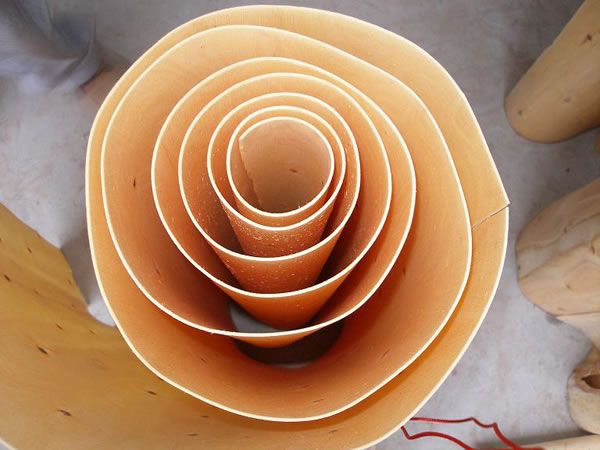It’s no secret here at Matilda Veneer that we love timber veneer and know the many ways it can be used to enhance building projects. But we understand that not everyone shares our enthusiasm or really even understands what veneer is and how it can be used.
The word “veneer” might give some people the impression that it is not real timber. That is not true, it is definitely real timber just a very thin slice of it! Veneer means “a thin decorative covering of fine wood applied to a coarser wood or other material.”
So veneer is timber adhered to other things that aren’t timber or lower grade, cheaper timbers. For example a sideboard might be made of MDF, but have timber veneer applied to the outside. Veneer is wonderful because you can have the look of expensive timbers without using as much of it. This is positive from a price perspective because it is cheaper to veneer with more expensive timbers than to build it wholly out of that timber. It is also a more efficient use of the timber as you can veneer many more things from one log than you can make from it. For example, one cubic metre of timber can produce 1000 square metres of veneer.
To make veneer, you need to peel or slice a log, which probably doesn’t sound easy to do. Thankfully we have machinery for this so we can achieve veneers to 0.6mm in thickness and even thinner depending on the specie.
There are a number of ways to peel or slice the log, but probably the easiest way to visualise the peeling process is to imagine a toilet roll, yes a toilet roll! If the log is the roll itself, a large knife is pressed against the log and the log rotates peeling off a thin layer of veneer, much like the paper coming off the toilet roll. This is known as ‘rotary cut’. ‘Sliced veneers’ are relatable to a block of cheese…The log (the block) moves up and down on a stationary knife cutting off thin slices of veneer, much the same way as a cheese grater or slicer.
The way a log is peeled or sliced has a major impact on the aesthetic of a veneer. In addition, no two logs are the same so we get pretty excited about the unique patterns that emerge as we peel or slice. Creating beautiful veneers also relies on sourcing quality timbers so we can offer our clients the highest quality veneers.
We source logs from around Australia and overseas, choosing only to work with suppliers that meet relevant certifications. This ensures the wood we use for our veneers is sourced in a sustainable manner, which supports forest management that protects animals, plants and communities for future generations.
Matilda Veneer is accredited under the PEFC and FSC® (FSC-C107681) Chain of Custody (CoC) Certification programs. CoC certification provides a guarantee about the production and source of products. From a customer perspective, it represents a promise that businesses certified by these programs are supporting responsible forest management.
Our commitment to sustainability is an important part of our business. As is our reputation for sourcing uncommon and hard-to-find timber species for veneer. This makes our products a favourite among architects, cabinet makers, interior designers and other design professionals that utilise or specify timber veneer. We are also known for producing high quality veneers, also referred to as “appearance grade”. We take our veneer very seriously and we hope this blog has given you an insight into the basics of veneer manufacturing as well as our commitment to quality and sustainability.
For more information about our products and our company, feel free to contact one of our expert team members, or follow us on Facebook or Instagram.



